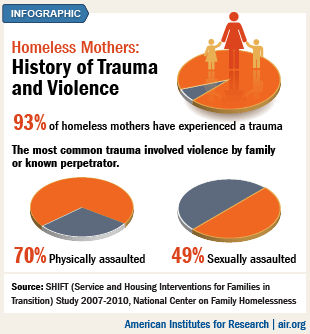Here at the Homeless Hub we love infographics. They are such a great way of conveying information. We’re going to share our favourites – created by us or others – every week, along with some research links to provide context.
This week’s infographic comes from the American Institutes for Research and is based on the “Service and Housing Interventions for Families in Transition (SHIFT) Longitudinal Study”.
This study “examines the effectiveness of different housing and service models in helping families who are experiencing homelessness establish and maintain residential stability and self-sufficiency.” While it has a focus in New York State the information can be transferred to the rest of the United States and similar data exists for Canada.
I found this comment in the report extremely striking, “Not since the Great Depression have significant numbers of families and children been homeless. During the 1980’s, families were a small segment of the homeless population, but in the last few decades their numbers have steadily climbed and now comprise approximately 38% of the overall homeless population.”
This meshes with a 2011 fact sheet from the YWCA’s Rose Campaign which says, “Violence against women is the leading cause of women’s homelessness in Canada. Every year, violence and abuse drive over 100,000 women and children out of their homes and into emergency shelters.”
What I think often gets missed is the connection to kids. If the leading cause of women’s homelessness is violence then the leading cause of children’s homelessness is also violence. Certainly there are linkages with other factors, such as poverty, but violence is key.
For street youth violence continues to play a role. A 2010 joint report from the Homeless Hub and Justice for Children and Youth “Surviving Crime and Violence Street Youth and Victimization in Toronto” found: 85.9% of female street youth reported being victims of crime compared to 71.8% of young males.
- This was true across all categories of crime including property crime and violent crime.
- 38.2% of female street youth reported being victims of sexual assault.
- Amongst female street youth, black females were much more likely to report being victims of sexual assault (47%) than were white females (33%).
- 60% of queer female youth report being victims of sexual assault during the past year.
The report also found that intimate partner violence (IPV) was also a serious issue for female street youth. “Over 55% report at least one incident of IPV (and of those, 79.5% reported more than one incident). Fifty-three percent reported emotional abuse, and 35% reported physical violence.”
Women’s Habitat of Etobicoke, a Violence Against Women shelter, has a very powerful PSA that speaks to the issues of violence and homelessness for women:


